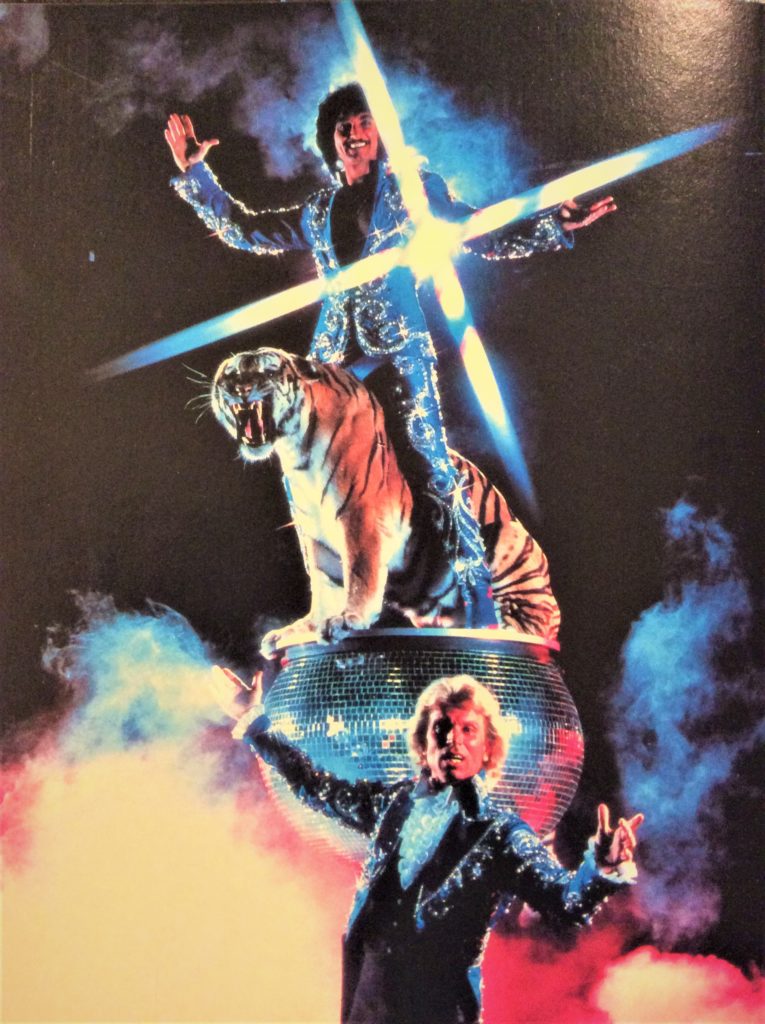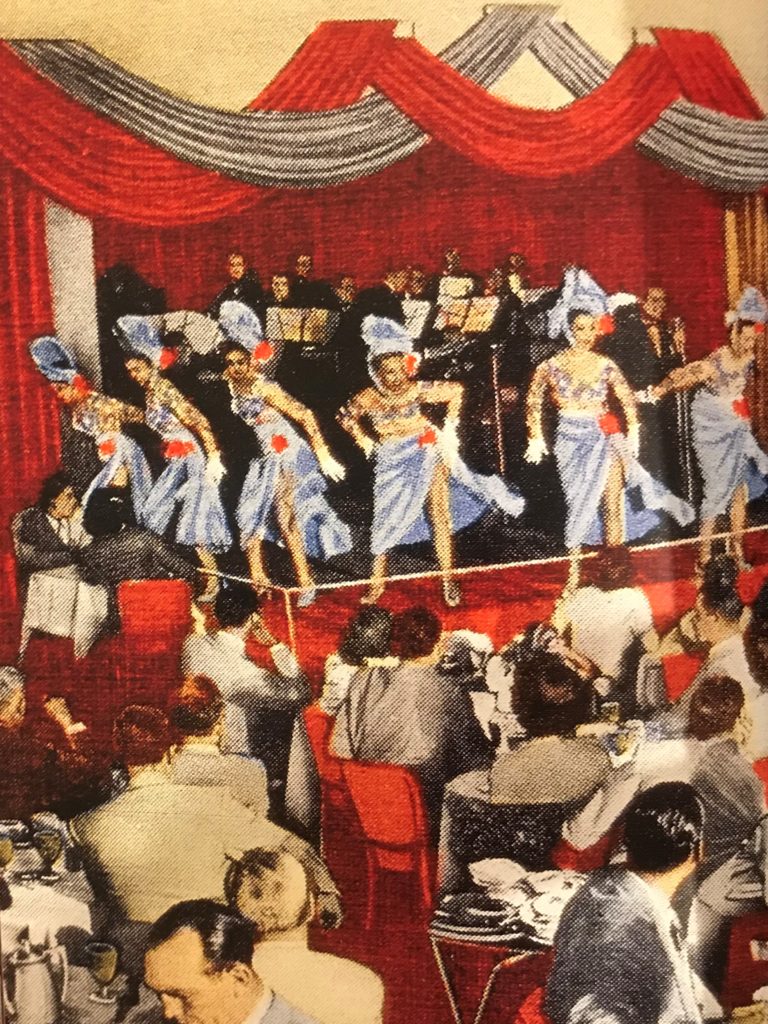Circus Goes Atomic! Spiegelworld’s New Show Goes from Edinburgh to the Las Vegas Strip
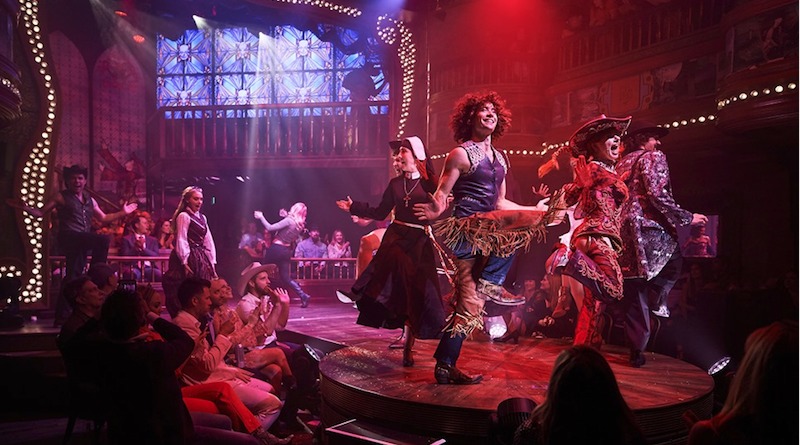
“Never create anything, it will be misinterpreted, it will chain you and follow you for the rest of your life.” Hunter S. Thompson, Fear and Loathing in Las Vegas
In 1967, Las Vegas’ Stardust executives welcomed the magicians/tamers Siegfried and Roy with this omen: “Magic will never work in this town.” In 1992, Guy Laliberté pitched a permanent circus concept (after Cirque du Soleil set theirNouvelle Experience big top in the brand new Mirage parking lot), only to have the door shut by Caesars’ bosses. These delays, for both the German duo and the Canadian troupe, were later mitigated by Steve Wynn who was to become the visionary who transformed the two illusionists into the longest-running success stories in the Strip’s history (with the producing support of Kenneth Feld from Ringling’s circus.) Later Cirque du Soleil entered into the miracle that forever changed the standard entertainment offer in Vegas (by building the very first permanent Vegas circus with Mystére in 1993). For both circus-rooted models, Wynn encouraged teams and aesthetics from “arty” and legitimate theater. It was a big farewell to the half-nude sequined dancers and naughty comedy jokes.
Circus acts have always been a ubiquitous guest of the lounge-acts industry of the Nevada gambling paradise if never a real main feature before Cirque du Soleil. By the mid-’50s, every music or comedy star regularly included in their shows one or two jugglers, magicians, and acrobats from among the finest in the world. The 60’s Parisian import of sophisticated revues, archived the spontaneous saloon entertainment format: instead, it imposed on Vegas polished productions with the feathered showgirl icon, emphasized the presence of visual acts, and incidentally established a circus market of circus talents there. In the 70’s, the launch of the “Circus Circus” resort, even with the novelty of world-class flying trapezes above the gamblers, was more a resort thematic variation than a circus presence. It is more due to Siegfried and Roy’s 90’s show redesign, which represented a key transition from the French-derived revue to a circus-type specialty based on spectacle (but through the lens of contemporary stage arts) that we have circus in LasVegas to this day. The two magician’s somber turn on mystical themes, deprived of feathers and sequins, were more closely related to the shadows ofCats than to the bright razzmatazz of Tropicana’sJubilee. Without sacrificing the visual excess necessary to a Vegas spectacle, this clearly paved the way for Wynn to run the dark and physical-skill based universe of Mystére. So, on the same premise of Wynn’s empire, Cirque du Soleil started to erode Feld’s circus space in town.

The rest of the story is well known. Cirque du Soleil multiplied their permanent presence with alternated successes; from the initial imprint of Franco Dragone as almost an artistic monopoly on the town (including his move from Soleil to indie, then moving directly from Celine Dion to Le Reve), to a differentiation of brands. Whereas the magician’s duo aesthetics reflected Vegas’ mutation toward a broader, non-gambler’s audience destination, Cirque du Soleil’s arrival following Wynn’s vision toward an “upscale” redesign of the Strip experience. The arty Quebecois troupe quickly became the perfect companion to the new level of high-end resort experience, boutique galleries and star-chefs restaurants. Cirque du Soleil’s landing in Las Vegas is now 27 years in the making. This is an eternity for the entertainment industry, for an ever-changing city, and even more so for the evolution of circus arts. But is Cirque du Soleil’s domination of Las Vegas circus destined to be eternal?
Circus for Adults: Time for Cabaret
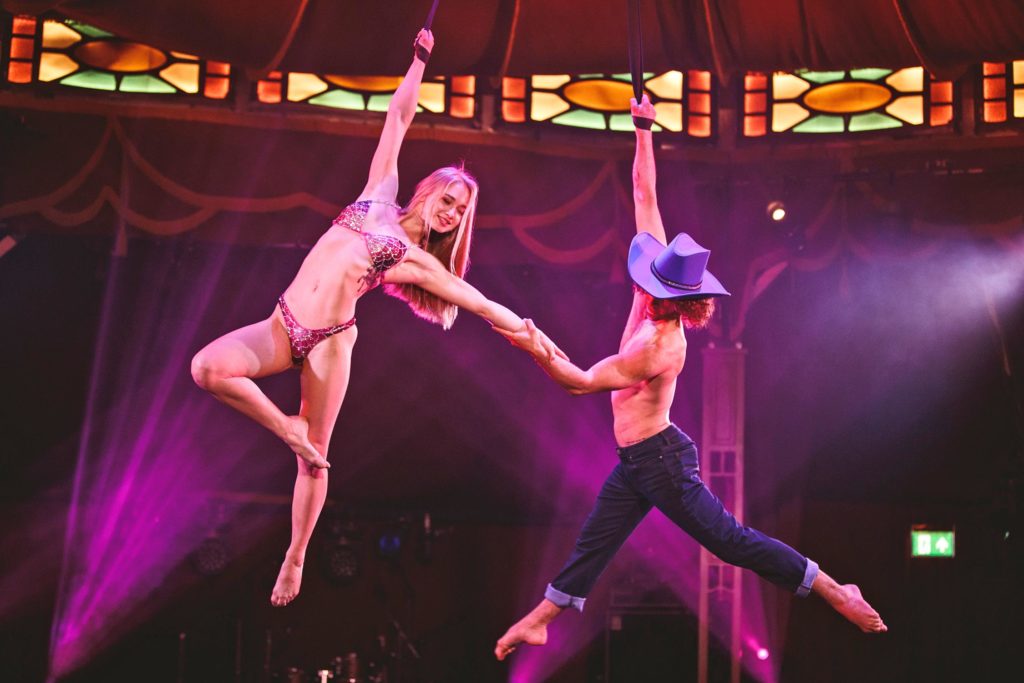
After 2000, the Vegas attendance started to shift from the recent family-oriented mutation to a new profile of visitor, linked to the expansion of the growing fair/convention business world. Cirque du Soleil took the opportunity for a move toward an adult oriented-project, withZumanity. If this seemed a sensational risk for Cirque du Soleil’s brand, again the adult-oriented circus spectacular was nothing new to the original Vegas’ DNA. Yet, to the next generation of Vegas visitor (beyond the rowdy gambler, this show touched on Vegas’ mythological past in a refreshing new way.
Zumanity‘s roots came from different sources. If the most recognizable one was the 90’s mainstream fetish culture and related aesthetics of glamour erotica, the recent European circus industry played an equally inspirational role. In the stage architecture, as in the dramaturgy of the project, it was recognizable in the recent continental trend of “spiegeltents” (the historical semi-permanent mirrored wooden, intimate big tops). These tents emerged in the late 80s in Switzerland (1985, Ueli Hirzel’s Circus Aladin). The concept was developed in 1988 byCircus Roncalli‘s founder Bernhard Paul, and soon became standard for immersive formats of character-based circus-cabaret/dinner shows. The versionPomp Duck and Circumstance was imported to the USA in 1995, then bought out and artistically revamped by Cirque du Soleil itself in Germany in 1997, thus generating a dozen similar experiences; in 1998, the first American model,Teatro ZinZanni, was initiated. In 2003, the opening of Zumanity pushed the envelope, transforming the concept into a resident format, bringing to Vegas the immersive genre of circus-cabaret; and, in this erotica variation, re-opening the Strip to its transgressive roots.
Enter Fringe and “La Clique”

In 2004, on the opposite hemisphere, at The Edinburgh Fringe Festival,La Clique premiered. A spiegeltent (originally from a brewer company) had been a long time casual venue of the Scottish Festival. Meanwhile, a new generation of circus/variety performers was taking shape between Northern Europe and Australia. Following a different approach from the polished Canadian-school, Russian or French acrobats, a less controlled kind of circus act was emerging. Contortionists, aerialists, and magicians developed a sexy and raunchy aesthetic based on humor, derision and popular culture, while keeping circus at an elevated level. This new spirit distanced us from the “circus-as-modern-dance” suggestion, and instead flirted with the emerging pop-retro, neo-sideshow, and new burlesque culture of the hipster neo-millennials. David O’Mer’s strap act in the bathtub, Capitan Frodo’s soliloquy while struggling into a tennis racket, or Ursula Martinez’ extreme strip-tease magic act, became modern icons as well as Youtube record setters.
La Clique, initiated by Australian producer David Bates and artistic director Brett Haylock, got rid of the previous format of spiegeltents as sophisticated banquet experiences, by stripping all to a raw sequence of acts: carnival folding chairs and popcorn replaced tuxedoed waiters and champagne. It became an uninterrupted touring world success. The formula repositioned the circus-variety genre in London and Montreal, took Australia by storm, and revamped the trends of variety in Germany (perhaps the only country where the genre had been popular and uninterrupted since late 19th century.)
A New Turn in Las Vegas
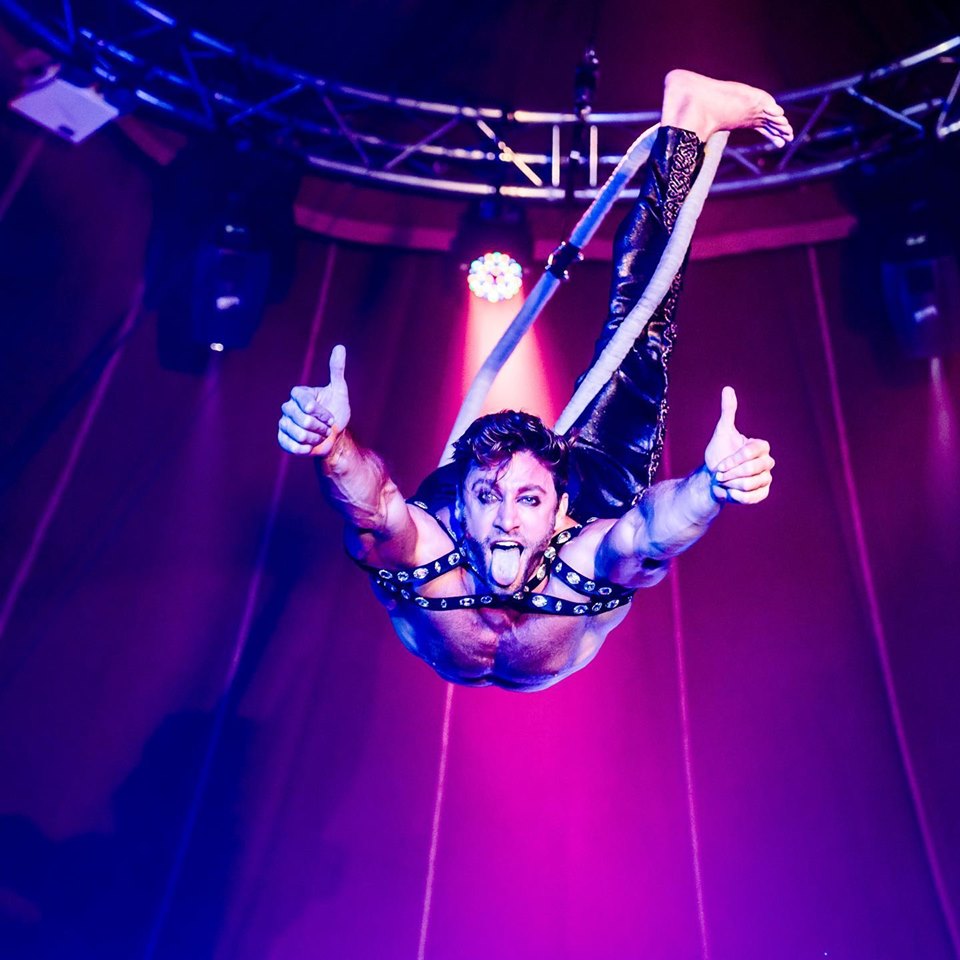
It was again an Australian, Ross Mollison, who was the man destined to give a dramatic evolution to the trend in America. By 2007, he launched thespiegeltentimmersive circus-variety Absinthe(and some subsequent titles)in New York. By keeping the La Clique model (raw acts deprived of the dinner- storyline experience), he emphasized one element: the emcee, as in the cabaret tradition. The “Gazillionaire” character became a hip icon, insuring a shade of backstory and a marketing personality to the experience. Eventually, Absinthe landed in Vegas in 2011, on the Caesar’s Palace premises. The small, informal tent turned out to be a lasting triumph, a must-see among the giant permanent circus epics, a well-played contrast of a ramshackle toxic tavern vs. the usual plush design casinos. The key of success was perhaps the intuition for a new pop perception of the circus. While Cirque du Soleil invested in producing in vitro acts with athletes from circus schools or sports, Absinthe just revived the old-school way of casting existing talents with their own artistic identity, and of the highest international class. The performer’s immediacy and spontaneity blended with the un-politically correct humor and shameless vulgarity of the leading character; thus emphasizing the casualness of the environment. Absinthe revived the timeless immersive nature of the joyful circus marriage between performer’s sweat and audience gasps. Sold as an “adult playground”, the concept perfectly updated the mythic “forbidden” aura of Las Vegas. With a following attempt (the short-lived Vegas Nocturne), Mollison and his Spiegelworld company finally played the new card of a custom-build venue for this intimate brand, reinforced with the successful Opium at Cosmopolitan by 2018.
The Game-Changing Saloon
The Edinburgh Fringe had been the source and laboratory for countless planetary successes (including circus, from Slava’s Snowshowto the aforementioned La Clique). 2019 is perhaps the first time it ever gave birth, and intentionally, to a major Las Vegas production. After all, the marriage between fringe and Vegas is perhaps reflecting a new kind of audience. It is a profile blending transgression and romanticism, culture and fun, vulgarity and class. It is a young audience aware of a brilliant post-Soleil circus resurgence in popularity, between TV talent shows and new hip imagery. In developing the concept of Atomic Salon Show, the Spiegelworld team brilliantly intercepted this fresh awareness toward circus and invigorated it with their sincere passion and competence for variety arts at their best. What they delivered is circus for the Netflix generation, with intriguing sub-plots, punch lines, suspense, soundtrack, and rhythm. This five million dollar production was rehearsed in Edinburgh for two months, then performed in one of the Assembly Festival‘s spiegeltents, before being sent to the Strip.
The show theme is western, although through the blender of some Vegas hallucinogenic experience: and it must be even more deliciously absurd in their new custom permanent circus-saloon carved into the italo-baroque canals of a Venetian Resort. The new venue’s design is halfway between a church and a brothel: reflecting the show’s parody struggling between religion and sin. If humor, mostly verbal, was already a key of Absinthe, here the guidance of director Cal Mc Crystal brings in a new added value: a strong basis of physical comedy, with specific characters and (as also in Opium) an appropriately loose storyline. If any act is emphasized as a traditional unit, each of the performers is magnificently integrated in the skin of the zaniest wild-west stereotypes: world-class acrobats merging with immensely talented comedians, headed by wonderful BritishclownessePetra Massey (of Spymonkey fame), in the role of bordello-owner Boozy Skunkton (a sort of vicious Doris Day). The casting is remarkable, both in circus quality as in theme-fitting personalities. Aerialist Davide Zangoli is “The Outlaw”; “The Mayor” is handstand acrobat Pavel Stankevich; a juggling nun (Fouzia Fofo Rakez); the cowgirl is Aylona with hula hoop; the country lovers (Jerome Simard and Alyna Shypnova) composing a compelling straps duo. For the latter, Alyona (a newcomer from Kiev circus school), the producers created the most thrilling pole dance act ever seen in Vegas. The naughtiest singing cowboy ever (Colin Cahill), a sexually tormented Reverend (genius comedian Gary Starr) and a farmer couple (thrilling Irish dance duo Peter Harding and Suzanne Cleary) are among the other colorful figures composing an ensemble indistinctly worthy of a Shakespeare comedy, a life-size naughty cartoon or the most glorious razzle-dazzle revue.
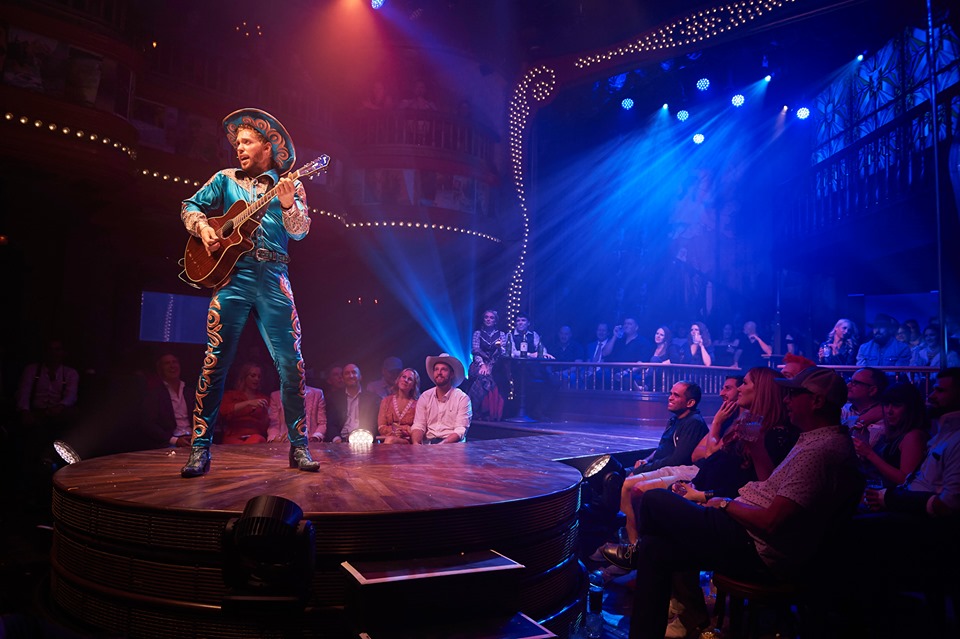
This approach can be a real game-changer: whereas Cirque du Soleil has been transforming athletes into stylized abstract characters of oneiric worlds on some abstract theme, here they are turned into more than realistic stereotypes of a dope trip; where we were used to an idea of modern circus as evolution of high art, Atomic punches us with its anarchic (still clockwork-designed) celebration of slapstick: the best choreographic ensemble piece being the final cartoonish fight (coordinated by former trapeze glory Richie Gaona). Here we don’t need to legitimize eroticism as a reflection on tribal cultures (as in some Zumanity’s moment); sex is a joyful subtext, innocently reminding us more of the grotesque playfulness of filmmaker Russ Meyer’s memory than the glossy pages of some arty coffee-table erotica. But glitter we have, with magnificent costumes that would obscure any eventual Broadway version of Blazing Saddles. Arty live world-music/new age bands are avoided too, favoring a playlist of high-energy pop or techno- country, add cartoon-like sound effects, perfectly fitting the acts and their spirit of parody. In Atomic Saloon, every taboo is punctually destroyed (the show opens and closes with an unbelievable launch of bread buns dispensed by nuns), every hypocrisy is exploded: not for the sake of some intellectual purpose but for the noble cause of happiness and wonder. The conceptors were able to brilliantly conjure a camp universe that stands as a long-due tribute to the forgotten early colorful years of Vegas entertainment. Atomic Saloon Show is great variety at its best– sexy, thrilling and fun; but above all, pure humanity, without the Z. All that through the means of the circus: the eternal repository of our life’s fantasies.
All photos provided courtesy of Atomic Saloon/Spiegelworld Press
Editor's Note: At StageLync, an international platform for the performing arts, we celebrate the diversity of our writers' backgrounds. We recognize and support their choice to use either American or British English in their articles, respecting their individual preferences and origins. This policy allows us to embrace a wide range of linguistic expressions, enriching our content and reflecting the global nature of our community.
🎧 Join us on the StageLync Podcast for inspiring stories from the world of performing arts! Tune in to hear from the creative minds who bring magic to life, both onstage and behind the scenes. 🎙️ 👉 Listen now!
